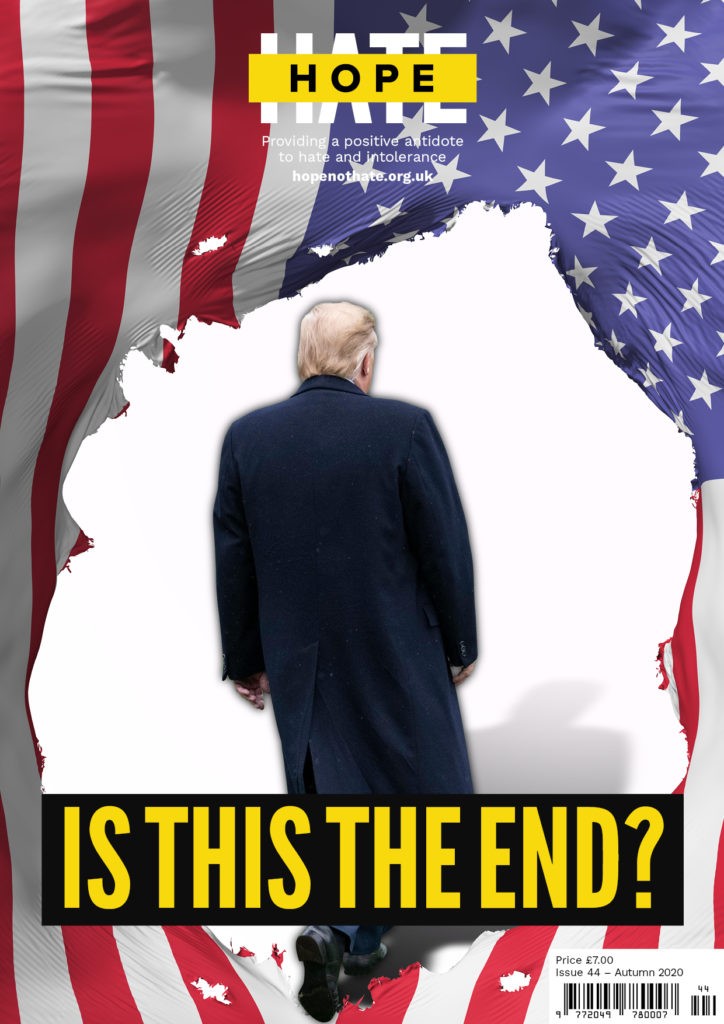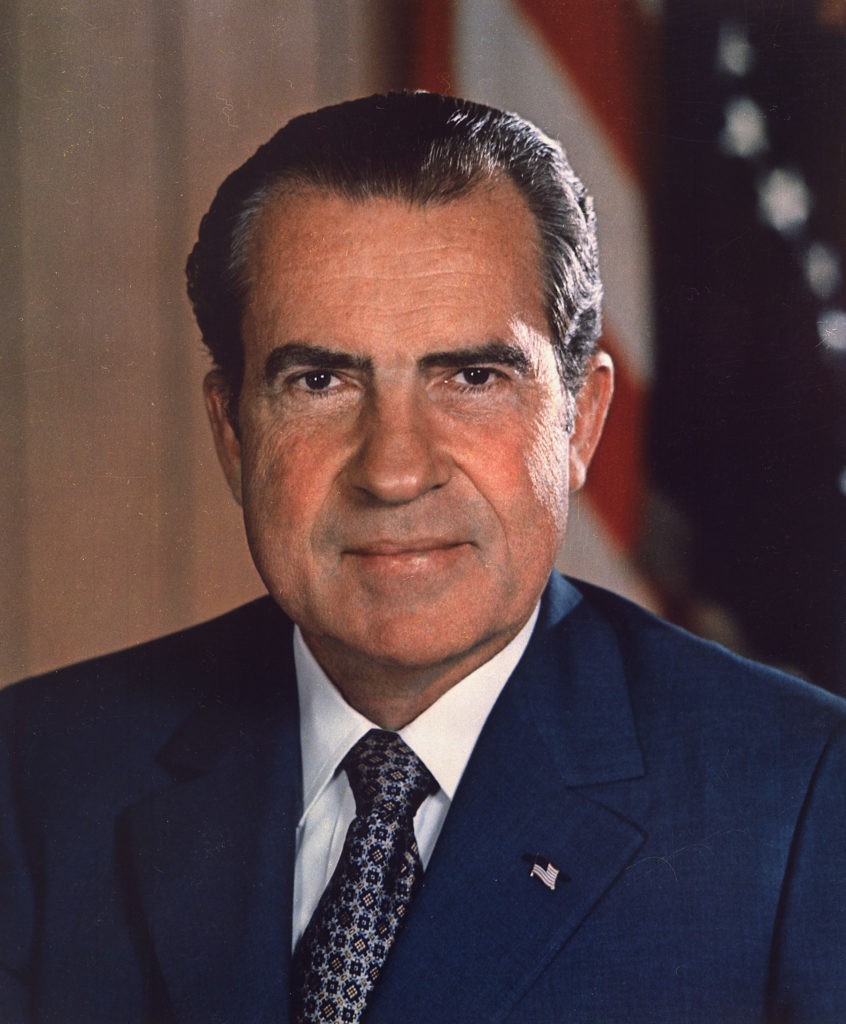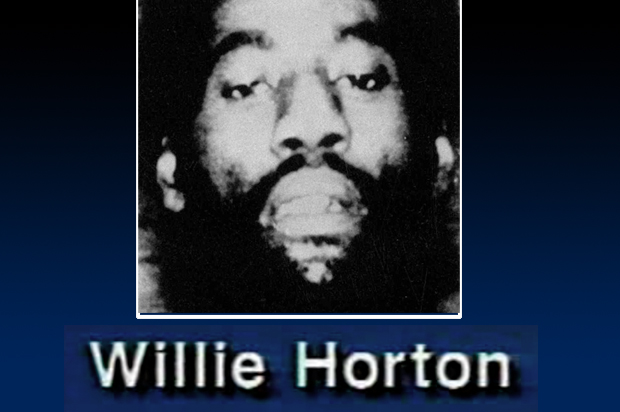HOPE not hate uses cookies to collect information and give you a more personalised experience on our site. You can find more information in our privacy policy. To agree to this, please click accept.

1968 WAS a pivotal moment in the history of American politics. Across the world people were rising, from the Prague Spring to Parisian students, anti-Vietnam war demos and the on-going struggle for civil rights in the US.

But revolt was also met by reaction, culminating in acts such as the assassinations of Martin Luther King and Robert F Kennedy, or the brutal beatings meted out to civil rights marchers at Selma and elsewhere in the deep south of the USA.
But there was another development taking place that year that was to lead to a dramatic upheaval in US politics and – eventually – to the election of Donald Trump in 2016. And this was the Republican Party’s presidential primaries.
The Republicans were still reeling from their heavy 1964 presidential defeat, when Democrat Lyndon Johnson stormed to victory with 486 votes in the electoral college, compared to the 52 won by Barry Goldwater.
George Romney, father of current Senator and former presidential challenger, Mitt, was the party’s frontrunner going into the primaries and represented the party’s moderate wing. He and his supporters believed that Republicans had to accept the changing country and adopt civil rights and equality legislation.
Four years before, at the Republican convention, the few black delegates had faced a torrid time. One had his suit set on fire, while another fled the conference hall in tears. “They call you ‘nigger’, push you and step on your feet,” he told reporters outside.
Barry Goldwater’s nomination in 1964 “marked the full embrace of a strategy that sought to win the votes of white Southern Democrats disillusioned by their party’s embrace of reforms aimed at racial equity,” 538’s Clare Malone has written. This strategy was – and continues to be – known as the ‘Southern Strategy’.

Romney’s front-runner status quickly evaporated as Richard Nixon stormed to victory and eventually to the White House. While Goldwater had proved too extreme, Nixon’s message was essentially the same, but slightly tempered. He secured the Republican nomination with the help of avowed segregationist Sen. Storm Thurmond. His Vice Presidential running mate was Spiro Agnew, who really ran with the Southern Strategy.
“His rise during the spring of 1968 is instructive because suddenly it feels so familiar: a white Republican who claimed to speak against radicalism and for the forgotten man, but in fact ran on exacerbating racial animosity,” Clay Risen wrote in The New York Times in 2018.
“Far from a bit player,” Risen said, “Agnew marked a watershed moment in American history, when the Republican Party committed itself to the shift from being the party of Lincoln to the party of white racial backlash.”
“Nixon tweaked this strategy,” says Angie Maxwell, director of the Diane Blair Center of Southern Politics and Society, speaking to me today. “And it coded the language a little bit, softened it a little bit.”
While the Southern Strategy is traditionally considered to be the adoption of racist politics by the Republicans, Maxwell has an alternative view.
“Nothing’s ever that simple.”
In 1976 the Southern Strategy appeared to hit the rocks when Jimmy Carter took much of the south as he stormed to victory. Once again, the Republicans went into some soul searching about whether to continue the Southern Strategy or change.
This is when, Maxwell argues, that the Southern Strategy evolved.
“Ronald Reagan had to try to find a way to appeal and win some of those white Southerners back [that] the party had lost in 1976. He does that not only by appealing to white racial angst, he’s going to expand it by appealing to anti-feminist, anti-Equal Rights Amendment white supporters.”
To Maxwell, this should be defined as ‘the long Southern Strategy’.
By the 1990s, following the strong showing by Bill Clinton across the South in his election victories, the Southern Strategy widened further, with George W Bush’s adoption of evangelicals.
Dr. Richard Land of the Southern Baptist Convention recalls:
“In this administration, they call us, and they say, ‘What is your take on this? How does your group feel about this?’” I don’t know if there’s any question that this administration understands that Southern Baptists and other evangelicals are a very significant part of their coalition. By some estimates, 40% of their raw vote came from evangelicals. Mr. Bush carried every state in which there was a significant Southern Baptist presence.”
“And it’s the combination of all three elements – racism, anti- feminism and evangelicals – that makes up the long Southern Strategy coalition,” says Maxwell.
“So when we look at white voters, if you express racial resentment, which is the scale we measure in political science, if you express modern sexism, which is kind of a new measure of sexism, and some kind of Christian nationalism, you know, most people are not all three, it’s a very small portion. That’s all three densest in the south. But still a small portion: a lot of people are two or three or one of three. But if you’re any of those that accounts for 95% of Trump’s white vote, the other 5%, the only kind of pattern we can find is a significantly higher income than normal voters.”

Maxwell stands out among many political scientists by stressing the role of gender politics on the Southern Strategy, including the active role of women. Central to these is Phyllis Schafly, whose story has been made famous to a worldwide audience through the Netflix series, Mrs America.
Schafly emerged in U.S. and Republican politics at a time when gender equality was gaining ground in the country and, if anything, was being led by the GOP (Grand Old Party – the Republicans).
“The Equal Rights Amendment (ERA) in the United States gets introduced in the Fall of ’71 and spring of ’72, and sails through Congress, both the House and Senate with almost 90% support,” recalls Maxwell.
“It was ratified in 30 states, so its momentum was huge and it needed just eight more states. And then Phyllis Schlafly of St. Louis starts her anti-ERA organisation and starts organising. She partners with a woman named Lottie Beth Hobbs, who’s high up in the Southern Baptist Convention. And that merger, and their activism in the south, took on a really dark dimension.
“They told Southern white women that the ERA would force them to work, put their babies in government daycare, serve on the front lines.
I mean, this scared them to death, right. And for those women, not having to work was kind of a status. It was a black woman who had to work. So it was aspirational not to work. That was the culture that was set up since antebellum times, completely intersectional with race.
“Southern white women in antebellum times had to be put up on a pedestal and protected from black men as a full justification for kind of white supremacy. But the institutions that were created to educate women, the cultural institutions, whether it was sororities, beauty pageants or junior leagues, continued and created this kind of aspiration for many people, like white femininity, and the counter which is a really hyper- masculine, you know, vision of men. And those women felt insulted by the Equal Rights Amendment and by feminists that they saw – and they marched to kill the Equal Rights Amendment.
“And with it they changed the Republican Party.”

Ronald Reagan might be remembered as the congenial former actor who appeared to get on with everyone, but in reality he was a ruthless exponent of the Southern Strategy, blending racism and anti-feminism into the GOP’s political philosophy.
“Reagan’s team polled 40,000 American women,” recalls Maxwell, “and they divided them into 64 categories that gave each category names like ‘Helens’, ‘Bettys’, ‘Nancys’. What they were trying to do is not look at the women’s vote as a monolith, which is good. But they saw that the women they needed to win back for their path to the electoral college victory were southern white women who did not support the ERA.
“So in 1980, the Republican Party dropped the ERA from its platform, after having been the first party to have adopted it, devastating Republican feminists. As a result, Reagan picks up tremendous numbers of Southern white women.”
Reagan’s Republicans even adopted the “family values” slogan that had originally been pitched by Phyllis Schlafly and Lottie Beth’s Hobbs in 1977.
“They see this as like a cleavage they can exploit in the states they need. And this leads straight into the effort to get religious voters. Schlafly was Catholic, but she used the anti-ERA movement to build a cross-denominational organisation between Mormons, Catholics and Baptists in the South, which had never happened before.
“So when people were surprised that many in the South would vote for Romney, because he’s a Mormon, well, I’m not, because Schlafly blurred those denominational lines.”
While most historians and political scientists see the Southern Strategy as a cultural reaction to the Civil Rights movement, and in particular the 1964 Civil Rights Act, Maxwell argues that it also had a mobilising effect on women who saw it as challenging and even upending their traditional way of life.
Suddenly African Americans – men and women – began to have access to higher education, training and the job market more generally and this began to impact on whites too. And that created a backlash. Women started to police each other, with those who did decide to go to work increasingly ostracised by other women within their communities.
“They were really trying to protect that collective Southern womanhood white womanhood, where women were on a pedestal. So in Georgia, for example, the anti-ERA forces chanted, ‘we don’t want to desexegate’. They even co-opted the language of opposition to civil rights and integration into their opposition to the Equal Rights Amendment.”

Many moderate Republicans like to view Donald Trump as an aberration, a departure from sensible conservatism, but of course he was a continuation and even possibly the culmination of the Southern Strategy. In fact, many of his key 2016 advisors had been pivotal in developing and evolving the strategy over the preceding 20 years.
Despite being the Governor of California, Ronald Reagan decided to announce his presidential campaign in 1980 in Mississippi. The person who convinced him to do that was a young Paul Manafort, who years later would become Donald Trump’s campaign chair (and later sent to prison for charges rising from his consulting work for the pro-Russian government of Viktor Yanukovych in Ukraine).
The person who helped make the infamously racist Willie Horton ad in 1984, which effectively ended Michael Dukakis’s presidential ambitions, was Roger Stone, a key Trump advisor, who years later would be implicated into the Russian hacking and Wikipedia leaks of Democrat Party emails and sent to jail (with his sentence later commuted by Donald J. Trump). Helping Stone was Roger Ailes, the man behind the rise of Fox News.
Another key figure was Republican political strategist Lee Atwater, who was credited with transforming and sanitising the Southern Strategy from its overtly racist roots. In an incendiary interview, given in 1981, he explains how Republican language had to change even if the general thrust of its racist approach did not.
“You start out in 1954 by saying, “Nigger, nigger, nigger.” By 1968 you can’t say “nigger”—that hurts you, backfires. So you say stuff like, uh, forced busing, states’ rights, and all that stuff, and you’re getting so abstract. Now, you’re talking about cutting taxes, and all these things you’re talking about are totally economic things and a by-product of them is, blacks get hurt worse than whites…. “We want to cut this,” is much more abstract than even the busing thing, uh, and a hell of a lot more abstract than “Nigger, nigger.”
“Manafort, Stone, Ailes and others kept pushing the party to go towards a kind of fundamental extremism. They created a lot of false equivalencies,” says Maxwell. “The victimisation rhetoric, the resentment rhetoric. And this really motivated people.”
There was some pushback inside the Republican Party to the Southern Strategy.
In 2005, Republican National Committee chair Ken Mehlman addressed the NAACP national convention to formally apologise for the GOP’s strategy. “Some Republicans gave up on winning the African American vote, looking the other way or trying to benefit politically from racial polarisation.
I am here today as the Republican chairman to tell you we were wrong.”
Following Barack Obama’s re- election in 2012, there was attempts by the moderate wing of the party to try to broaden its base. Five Republican strategists wrote the Growth and Opportunity Project in an attempt to shift strategy: “Many minorities wrongly think that Republicans do not like them or want them in the country,” it said.

This report obviously did not have the desired impact, as three years after its publication, Donald J. Trump was elected President of the United States by successfully blending racism, anti-feminism and religious fundamentalism – the three key pillars of the Long Southern Strategy.
Trump’s success was driven by the likes of Jeff Sessions, Paul Manafort and Steve Bannon, who all argued that rather than copy Obama and gravitate towards his growing and urban coalition, it was best to turn further to the hard right – and by extension double down on the Southern Strategy.
For Maxwell, Trump’s 2016 was all too predictable. “I gave a series of talks in 2016 called the inevitability of Donald Trump. It wasn’t that he would win the general election, though I was very worried. It was that he’d get the Republican nomination.
“It was a crowded field, but when you looked at who was playing those three cards the hardest, people said well, why not Ted Cruz or Marco Rubio? And I’m like, because their last names are Cruz and Rubio. Why not Ben Carson? Because he’s black. Carly Fiorina, because she’s a woman. Trump validates those feelings that many in the GOP already had, but also poured gasoline on those fires. So he is the combination, he’s not an anomaly. He’s the combination of where the party had gone. The Democrat Party moved to the left and the Republican Party decided to take these right turns on these issues.”
With Donald Trump some way behind in the polls, the future of the Southern Strategy must now be in question. In the lead-up to the election, Trump decided to double down in an attempt to get even more of the party’s core base out to vote rather than building bridges with more diverse constituents, but if the polls are accurate this might not be enough.
But let’s not fool ourselves in thinking the Southern Strategy itself will be ditched. Just as it has changed during the 1970s and 1980s, so it might change again: this time bringing more politically and religiously conservative-leaning Latinos. Or it might just carry on before, rejuvenating itself in opposition to a Democrat presidency.
And let us not forget, if it was not for the advent of the coronavirus pandemic, it’s likely that Trump would have been re-elected and the Southern Strategy would have been seen to succeed for the Republicans once again.
Nick Lowles (@lowles_nick) is CEO of HOPE not hate.
Angie Maxwell (@AngieMaxwell1) is the Director of the Diane Blair Center of Southern Politics and Society, an associate professor of political science, and holder of the Diane Blair Endowed Professorship in Southern Studies at the University of Arkansas.

Right-wing comic Kearse saves the worst material for his anonymous Telegram account HOPE not hate has identified an anonymised Telegram account belonging to the GB…